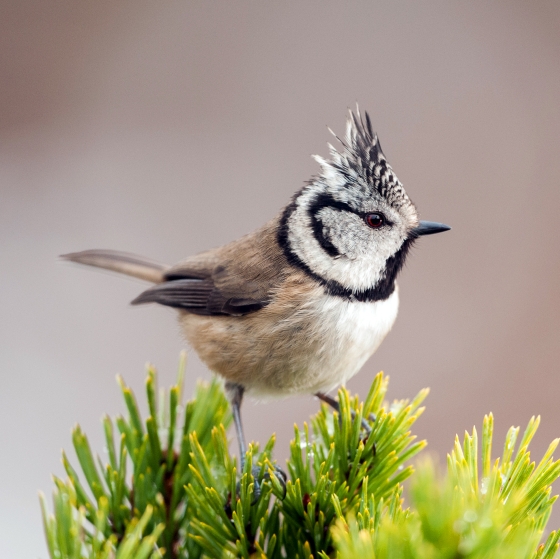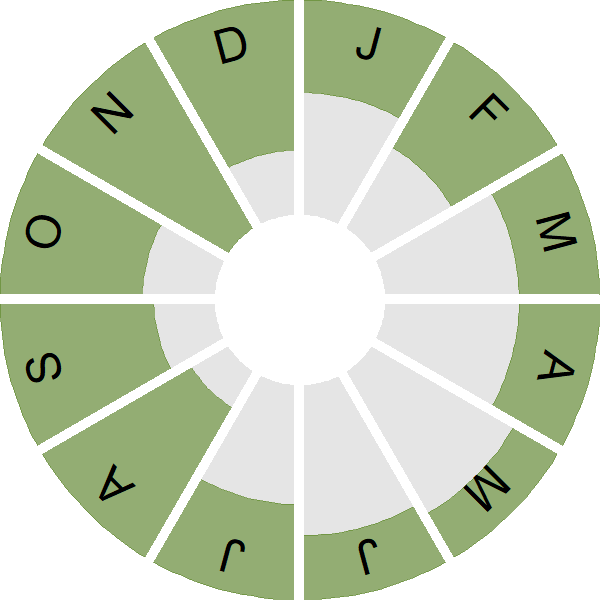Crested Tit

Introduction
This attractive small tit is only resident in a restricted area of northern Scotland.
Although this species' range extends across large parts of Continental Europe, in Britain & Ireland Crested Tits can only be found in a northern Scotland, largely in the ancient Caledonian pine forests and Scots Pine plantations. Here, Crested Tits can be spotted working their way through the trees in search of pine seeds and invertebrate prey. They are also known to visit garden feeders. In winter, Crested Tits will join flocks with other tit species. At this time of year, Crested Tits will also cache food.
While the Crested Tit's body plumage is not dissimilar to that of a Marsh Tit or even a Coal Tit, its head plumage is unmistakable. It has a black collar, bib and stripe that extends from each eye and curls around the cheek, and then its black and white crest, which can appear extended or flattened back. Pairs make one to two breeding attempts per year, with females excavating a nest in dead wood, which is then lined with moss, lichen, hair or cobwebs before the eggs are laid.

Key Stats
Identification
Songs and Calls
Song:
Call:
Status and Trends
Conservation Status
Population Change
Although widespread on the continent, Crested Tits in the UK are restricted to Scottish pinewoods. The trend is uncertain but appears to be stable (Summers & Canham 2001). The breeding Atlas shows a 28% increase in the number of occupied 10-km squares since 1968–72 but this may be at least partly caused by differences in observer coverage.
Distribution
The Crested Tit is an iconic species of the pinewoods of northern Scotland, where it has a very restricted distribution. Its core range covers the Caledonian pinewoods of upper Strathspey to the pine plantations of lower Strathspey and the coastal plains of Moray and Nairn. In Easter Ross and east Inverness Crested Tits are found at low densities in pine plantations, especially those containing patches of relict forest.
Occupied 10-km squares in UK
2007/08–10/11
or view it on Bird Atlas Mapstore.
2008–11
or view it on Bird Atlas Mapstore.
European Distribution Map
Distribution Change
Apparent range expansions in winter and the breeding season have mostly occured in the lower-density areas west of the Great Glen and are probably influenced by increased observer effort, particularly in winter. New plantings, especially of Scots Pines, and sympathetic forest management may also be leading to local increases in numbers and range expansion.
Change in occupied 10-km squares in the UK
from 1981–84 to 2007–11
or view it on Bird Atlas Mapstore.
from 1968–72 to 2008–11
or view it on Bird Atlas Mapstore.
Seasonality
Crested Tit is a very localised breeder and can be encountered year-round in the right habitat.
Weekly pattern of occurrence
The graph shows when the species is present in the UK, with taller bars indicating a higher likelihood of encountering the species in appropriate regions and habitats.

Movement
Britain & Ireland movement
Foreign locations of birds ringed or recovered in Britain & Ireland
Dots show the foreign destinations of birds ringed in Britain & Ireland, and the origins of birds ringed overseas that were subsequently recaptured, resighted or found dead in Britain & Ireland. Dot colours indicate the time of year that the species was present at the location.
- Winter (Nov-Feb)
- Spring (Mar-Apr)
- Summer (May-Jul)
- Autumn (Aug-Oct)

Biology
Productivity and Nesting
Nesting timing
Egg measurements
Clutch Size
Survival and Longevity
Survival is shown as the proportion of birds surviving from one year to the next and is derived from bird ringing data. It can also be used to estimate how long birds typically live.
View number ringed each year in the Online Ringing Report.
Lifespan
Survival of adults
Biometrics
Wing length and body weights are from live birds (source).
Ring Size
Classification, names and codes
Classification and Codes
- Order: Passeriformes
- Family: Paridae
- Scientific name: Lophophanes cristatus
- Authority: Linnaeus, 1758
- BTO 2-letter code: CI
- BTO 5-letter code: CRETI
- Euring code number: 14540
Alternate species names
- Catalan: mallerenga emplomallada europea
- Czech: sýkora parukárka
- Danish: Topmejse
- Dutch: Kuifmees
- Estonian: tutt-tihane
- Finnish: töyhtötiainen
- French: Mésange huppée
- Gaelic: Gulpag-stuic
- German: Haubenmeise
- Hungarian: búbos cinege
- Icelandic: Toppmeisa
- Italian: Cincia dal ciuffo
- Latvian: cekulzilite
- Lithuanian: europine kuoduotoji zyle
- Norwegian: Toppmeis
- Polish: czubatka (europejska)
- Portuguese: chapim-de-poupa
- Slovak: sýkorka chochlatá
- Slovenian: copasta sinica
- Spanish: Herrerillo capuchino
- Swedish: tofsmes
Research
Causes of Change and Solutions
Causes of change
A survey in 1992–95 found that 35% of Crested Tit were in native pinewoods with the remaining 65% in Scots pine plantations, suggesting that plantations have helped to maintain the Crested Tit population. However, densities are ten times higher in native woods and hence any benefits of plantations are likely to be limited unless management actions are undertaken to improve habitat for Crested Tits (Summers 2000).
Information about conservation actions
See Summers 2000 re plantations
More Evidence
More evidence from Conservation Evidence.com
Partners
Citing BirdFacts
If you wish to cite particular content in this page (e.g. a specific value) it is best to use the original sources as linked in the page. For a more general citation of the whole page please use: BTO (20XX) BirdFacts Species: profiles of birds occurring in the United Kingdom. BTO, Thetford (www.bto.org/birdfacts, accessed on xx/xx/xxxx).

